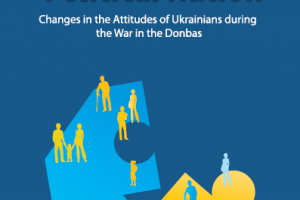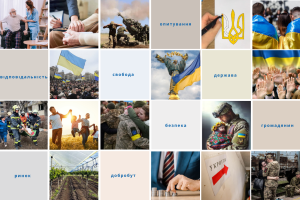METHODOLOGY
A nationwide survey was conducted by the Ilko Kucheriv Democratic Initiatives Foundation in cooperation with the Kyiv International Institute of Sociology from 6 December 2024 to 9 January 2025.
The survey employed the CAPI method (computer-assisted personal interviewing) to collect responses from 2,580 individuals aged 18 and over, residing in government-controlled areas of Ukraine. The survey did not cover the Donetsk, Sumy, and Kherson regions due to security-related restrictions.
A three-stage random sampling method was used, with quota selection applied at the final stage. The sample structure reflects the demographic composition of the adult population in the surveyed areas as of early 2022, in terms of age, gender, and type of settlement.
The theoretical margin of sampling error does not exceed 2.9%, with a confidence level of 95% and a design effect of 1.5.
However, additional systematic deviations may have arisen due to the impact of Russian aggression, particularly the forced displacement of millions of citizens.
Composition of Macro-Regions:
- West – Volyn, Zakarpattia, Ivano-Frankivsk, Lviv, Rivne, Ternopil, and Chernivtsi regions;
- Centre – Vinnytsia, Zhytomyr, Kyiv, Kirovohrad, Poltava, Khmelnytskyi, Cherkasy, Chernihiv regions, and the city of Kyiv;
- South – Zaporizhzhia, Mykolaiv, and Odesa regions;
- East – Dnipropetrovsk and Kharkiv regions.
SURVEY RESULTS
Forty-six percent of respondents prioritised freedom over security, while 34% indicated a willingness to relinquish some of their rights and civil liberties to the state in exchange for security. Twenty percent were unable to decide between the two proposed alternatives. Compared to August 2022, the share of respondents willing to face potential danger for the sake of personal freedom and guaranteed civil rights increased from 35% to 46%, while the proportion of those who prioritised security over freedom dropped from 39% to 34%.
1. Which of the following statements do you agree with more?
Regardless of gender, respondents generally considered freedom more important than security. However, among women, the proportion willing to risk danger for personal freedoms was lower than that among men—41% compared to 52%, respectively.
Half of the respondents (51%) in the 18–29 age group agreed that they are willing to face danger for the sake of personal freedom and guaranteed civil rights. As age increases, the proportion of respondents holding this view decreases. For example, among respondents aged 60 and above, 42.5% selected this option.
In contrast to other macro-regions, respondents residing in the eastern regions were more likely to prioritise security over freedom (38%) rather than vice versa (34%).
Respondents living below the poverty line were more likely to consider security more important than freedom compared to their more affluent counterparts: 37% versus 22%, respectively. Conversely, the proportion of affluent respondents who believe freedom is more important than security was higher than that of those living below the poverty line: 58% versus 37%, respectively.
Despite some fluctuations over the years, respondents have consistently placed freedom above prosperity. Between December 2024 and January 2025, 60% of those surveyed indicated they are willing to endure material hardships for the sake of personal freedoms and guaranteed civil rights, while 24% are willing to relinquish their rights and civil liberties to the state in exchange for their own well-being. Another 16% were unable to choose between the two options.
Compared to 2023 and 2021, the percentage of respondents prioritising well-being at the expense of freedom remained within the statistical margin of error. The proportion of those prioritising freedom over well-being rose from 40% to 47% between 2021 and 2023, and from 47% to 60% between 2023 and 2025. In both cases, this increase occurred at the expense of respondents who had previously been undecided on the issue.
2. Which of the following statements do you agree with more?
Among the macro-regions, the smallest proportion of respondents willing to endure material hardships for the sake of personal freedoms is found in the eastern regions (47%), while the largest proportion is in the western regions (66%). This discrepancy persists due to differences in the proportions of respondents selecting each of the proposed answer options.
Fifty-four percent of those surveyed believe that the state should provide people with equal conditions and opportunities in life, after which individuals are responsible for how they utilise those opportunities. Meanwhile, 39% believe the state should assume full responsibility for providing every individual with everything necessary for their life and development. Compared to previous years when the DIF posed this question, the distribution of respondents between these two options has not changed significantly. The exception was in 2016, when 45% of respondents believed the state should fully assume responsibility for ensuring the population's well-being.
3. Which of these statements do you identify with more?
The smallest proportion of respondents who support the idea that the state should only ensure equal 'rules of the game'—and that, from then on, individuals bear responsibility for how they use these opportunities—is found in the eastern regions (41%), while the largest proportion is in the western regions (60%).
Respondents living below the poverty line, compared to those with higher levels of wealth, more frequently reported that the state should assume full responsibility for the population (50%), rather than individuals being accountable for their own lives (42%).
Seventy-seven percent of those surveyed agreed that citizens should be the highest priority, meaning that the interests of the state must be subordinate to the will of the citizens. Meanwhile, 16.5% believe that the interests of citizens should be subordinate to the will of the state. The smallest proportion of respondents who agree that the state must serve the will of its citizens is found in the eastern regions (66%).
4. Which type of interaction between the state and its citizens do you consider preferable?
Fifty-seven percent of respondents support a market economy, believing that Ukraine's economy should be predominantly market-regulated, with citizens' incomes depending on their own efforts and skills in the labour market. Meanwhile, 31% favour state regulation of the economy, believing that the economy should be primarily state-regulated, with citizens' incomes redistributed through higher taxation of wealthier segments of the population.
5. What type of economic system do you consider most desirable for Ukraine?
Those living in the western regions (65%) show the greatest support for a market-regulated economy, in which citizens' incomes depend on their own efforts. Conversely, respondents in the eastern regions (50%) show the least support for this position. The difference in response rates among the macro-regions is largely due to a higher proportion of respondents in the eastern regions who were unable to select a single option from those proposed.
Respondents who are very poor or poor are more inclined to favour state regulation of the economy and redistribution through higher taxation of wealthy individuals, compared to those who are conditionally well-off or well-off: 38% and 37% versus 26% and 25%, respectively. Nevertheless, even among the poor and very poor, a relative majority prefer a free market and reliance on their own efforts.
More than half of the respondents (59%) agree that, when making decisions, politicians should rely on the will and sentiments of the majority of the population, rather than follow the conclusions of authoritative experts. Conversely, 32% hold the opposite view.
6. What should politicians primarily rely on when making decisions?
The largest share of respondents who believe that politicians should make decisions based on the will and sentiments of the majority of the population is found in the western regions (62%), while the smallest share is in the eastern regions (53%). However, this difference is partly due to a higher proportion of respondents in the eastern regions who were unable to choose between the two proposed response options.
Extremely poor and poor respondents were more likely than conditionally well-off and well-off respondents to agree that politicians should make decisions based on the will and sentiments of the majority: 64% and 62%, compared to 56% and 55%, respectively. Conversely, conditionally well-off and well-off respondents were somewhat more likely to agree that politicians should make decisions based on the conclusions of authoritative experts: 35% and 36%, compared to 28% among the poor and 25% among the extremely poor.








